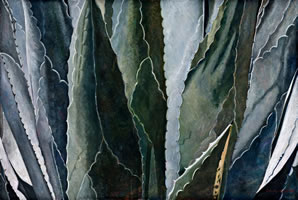Adriana Moncada
Mexicans possess the need to create in their genes: Pedro Diego Alvarado Pedro Diego Alvarado has his work of 28 pieces in tempera and oil on canvas on exhibition, since yesterday, at the Galería de Arte Mexicano. The artist presents an intimate vision of his home, his garden and his studio, in other words,
The artist is accomplished in landscapes and nudes, but for now he prefers still lifes “because they can be controlled by the lighting and the composition; besides, there are not many painters in Mexico that are interested in interpreting nature within the classic standards, an interest that does exist in several European countries, where they are dedicated to recovering all the pictorial knowledge that, little by little, has been disappearing. I think this is because the ‘isms’ have been exhausted there, while here there continues to be many classic and modern painters. Unfortunately, he adds, the craft is being lost, “It’s something that has freed painting, but that has also led it to a dead end street, which is why I believe its important to return to the source and connect up with thousands of years of painting behind us. We should root and confront ourselves with the history of humanity and art”. Alvarado lives in Tepoztlán, Morelos. He explains: "I paint what surrounds me. Of course, if I lived in this city I would paint other subjects. So, my themes are Mexican, though I don’t repeat shapes or backgrounds. I am Mexican, I live in Mexico and I paint directly from nature, that’s why objects that surround us necessarily appear in my work. The main problem, "both for painting and for today’s painters, is trying to discover what we’re going to do at the end of the century, in this changing era. In my case, I discovered some time ago that light is the most important thing and it is reflected by each painter according to his own country of origin; Mexico "is a very generous country with its artists: both at the private and government levels. It’s a country of great beauty, which is the reason there are so many talented painters, besides the fact that we possess the need to create in our genes. This need, along with our past, gives as a result the quality of art that is created here”. Pedro Diego Alvarado explains that he uses tempera because it provides more quality and durability, since oils “have too many additives, and besides being expensive, never dry and can ruin very quickly". uno más uno |
|

 “my daily life, because I am interested in retrieving and delving into the craft of painting, since it is the path to follow at the end of this century”. By observing the work of Alvarado, we are submerged in nature, in banana orchards, prickly pears and lilies; in old kitchens, cabbages, onions, squash and tomatoes; and even into his studio, his paint cans, his tables, chairs and his easels.
“my daily life, because I am interested in retrieving and delving into the craft of painting, since it is the path to follow at the end of this century”. By observing the work of Alvarado, we are submerged in nature, in banana orchards, prickly pears and lilies; in old kitchens, cabbages, onions, squash and tomatoes; and even into his studio, his paint cans, his tables, chairs and his easels. A graduate of La Esmeralda, Pedro Diego studied in San Carlos with Gilberto Aceves Navarro and at the Escuela Superior de Bellas Artes in Paris, France, where he drew and painted close to Henri Cartier-Bresson. He has presented approximately ten solo exhibits and in 1989 he created the mural for the main vestibule of the Amparo Museum in the city of Puebla (Mexico).
A graduate of La Esmeralda, Pedro Diego studied in San Carlos with Gilberto Aceves Navarro and at the Escuela Superior de Bellas Artes in Paris, France, where he drew and painted close to Henri Cartier-Bresson. He has presented approximately ten solo exhibits and in 1989 he created the mural for the main vestibule of the Amparo Museum in the city of Puebla (Mexico). Rembrandt is the light of the Netherlands, Cézanne of the south of France and ours is so strong that is results in a very graphic painting. Light, therefore, is linked to culture and geography and it’s the line to follow being such a universal and eternal element".
Rembrandt is the light of the Netherlands, Cézanne of the south of France and ours is so strong that is results in a very graphic painting. Light, therefore, is linked to culture and geography and it’s the line to follow being such a universal and eternal element".